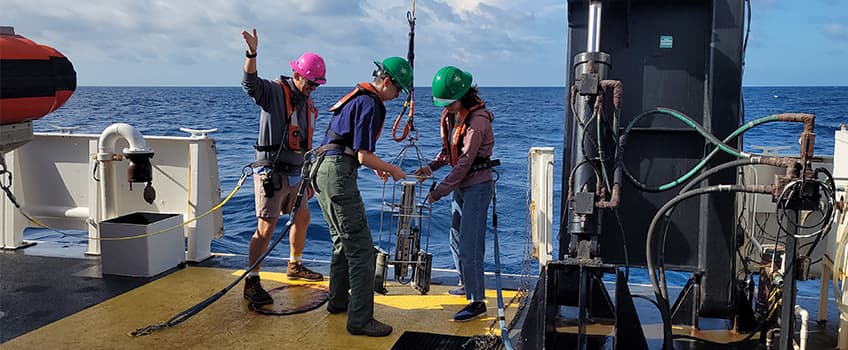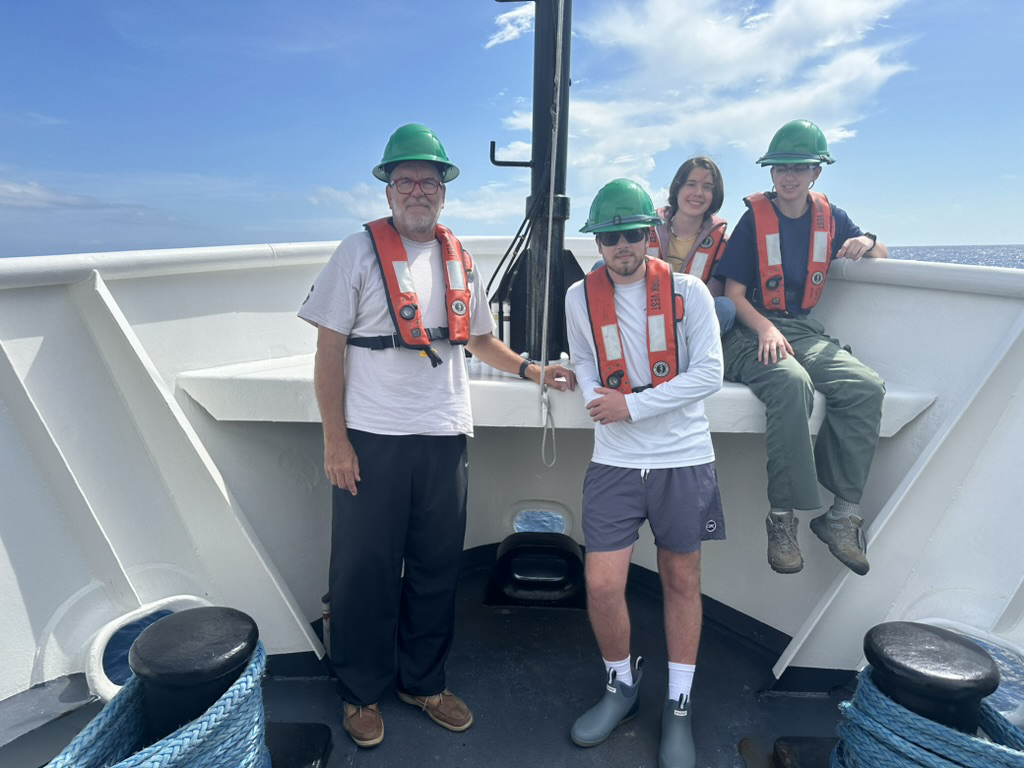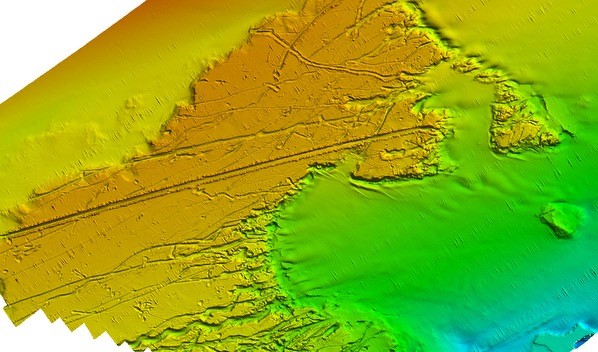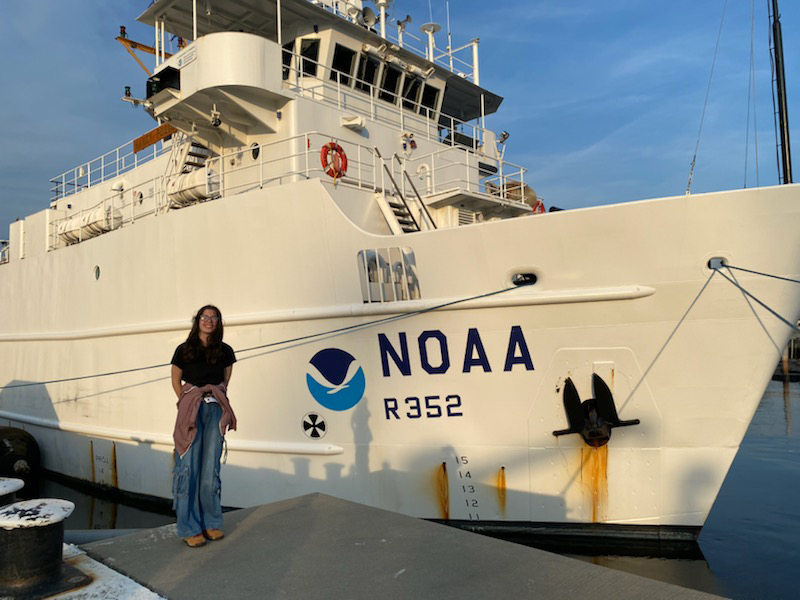Students Study Ocean Depths on Inaugural NOAA Cruises

A National Oceanic and Atmospheric Administration technician helps Stockton University students Lora Panepinto, of Staten Island, New York, and Hannah Elliott, of Bridgewater, measure conductivity, temperature and depth of the ocean water off the side of the NOAA vessel Nancy Foster during their week-long cruise in July.
Galloway, N.J. — Lora Panepinto has always been comfortable on the water. The Stockton University sophomore spends her summers teaching kids boat safety at the Liberty Nautical Education Center on the Rahway River.
“I’m pretty used to nasty weather and being on a boat,” said the Staten Island, New York, native.
But nothing prepared her for spending a week 140 miles offshore, studying the ocean floor 1,500 feet deep on a 186-foot research vessel.

From left, Stockton Adjunct Professor Steve Nagiewicz with Stockton students Dustin Horensky, Hannah Elliott and Lora Panepinto on the NOAA vessel Nancy Foster during an expedition examining the ocean floor from July 15 to July 21.
“I don’t even think there’s enough words to explain it,” said the double major in Marine Science and Environmental Science. “It changes your view of what being on the water can look like. When you are out in the open water and you don’t see land, it kind of opens up your world a bit.”
Panepinto was one of six Stockton students who took part in a first-time series of cruises with the National Oceanic and Atmospheric Administration (NOAA) ship Nancy Foster in July. The students lived and worked with a NOAA crew as it mapped the ocean floor off the coast of South Carolina. Alanna Weeks, Mackenzie Briggs and Seth Sims sailed from July 5 to July 12, and Dustin Horensky, Hannah Elliott and Panepinto traveled from July 15 to July 21.
“It is rare that undergraduate and graduate students get an opportunity to sail aboard a NOAA vessel,” said Julia Wallace, a physical scientist with NOAA’s Office of Coast Survey. “These cruises enable groups of students from several academic institutions to experience hydrographic mapping operations, life at sea aboard a NOAA vessel, and network with other marine science students from across the country.”
Stockton was one of only six schools invited by NOAA to send students.
“Stockton is one of a handful of schools in the country that offer undergraduate training in the field of hydrography and marine technology,” said Steve Evert, the director of Stockton’s Marine Field Station in Port Republic.
Hydrography is the science of measuring and describing the physical features of bodies of water and their adjacent lands. The NOAA cruises used multibeam sonar to scan and map the ocean floor as part of a project titled Seabed 2030 that aims to map the entire ocean floor by 2030. During each of the cruises, the vessel used a powerful multibeam sonar to scan and map the sea floor by creating a grid with dozens of lanes, often 40 miles long, to build a bathymetric three-dimensional image of the sea floor.

An image of the ocean floor about 140 miles off the South Carolina coast at a depth of about 1,500 feet. The groove is believed to have been created by the scraping of an iceberg as it broke off from a glacier about 10,000 years ago.
“It’s like cutting your grass on the ocean floor but never stopping,” said Stockton Adjunct Professor Steve Nagiewicz, who joined the students on the second July tour. “We know more about the surface of the moon and Mars than what the bottom of the ocean looks like. Mapping the sea floor allows us to better understand how our own planet works, how the ocean affects atmospheric currents and how it affects the distribution of life in the ocean.”
Students also shadowed NOAA scientists and technicians while they conducted hydrographic survey operations for charting purposes. The students watched the sonar data come in live on large computer screens and then learned how that data was processed. After the cruise, each of the students received a letter certifying they had learned enough to become official NOAA hydrographers.
“I’m a little bit of a computer nerd myself,” said Horensky, an Environmental Studies major who is also studying geographic information systems (GIS) at Stockton. “I really enjoy anything with the processing of data. It was almost like a minigame. Some of the other students thought it was a little tedious, but I enjoyed sitting there messing around with the data.”
Being miles away from land wasn’t a problem for Horensky, as the Beach Haven native has spent his entire life surfing the Atlantic Ocean, clamming the bays and even fishing for tuna or marlin 100 miles offshore. He loved being able to not only observe NOAA employees but also take part in some of the experiments. Each day, the Stockton students would help measure conductivity, temperature and depth profiles off the side of the vessel to get a real feel of the water and provide necessary vertical water column data to the sonar equipment.

Hannah Elliott, a sophomore Marine Science major, stands in front of the NOAA vessel Nancy Foster before it leaves the Federal Law Enforcement Training Center in North Charleston, South Carolina, for the third of three week-long cruises featuring college students.
For Horensky, the cruise demonstrated how his love of the sea and statistics could turn into a potential career.
“I was a little different because most every other student out there was in the marine science field,” the senior said. “It was an eye-opening experience of what it would be like if I entered this field. I never really thought I’d be able to do something like this, but now I feel like this is a pretty likely candidate for what my career could turn into.”
Panepinto said the cruise also showed her that you don’t have to become a professor or researcher if you are interested in oceanography — the hands-on work by the NOAA technicians is just as important.
“They gave me a slice of what my life could be in a couple of years, and they did it with a lot of fun and kindness,” she said. “This is something that not a lot of people who just completed their first year of college get to do.”
That’s exactly what Evert wants to hear as he has been encouraging Stockton’s effort to increase its teaching and research programs in oceanography and hydrography.
“These cruises show how we are advocating for our students and getting them experience outside of Stockton,” he said. “All of this stuff is about jumpstarting their career and helping them graduate with a resume that is way more than just a list of classes and a GPA. It’s got a list of meaningful experiences that resonate with future employers.”
— Story by Mark Melhorn, photos provided by Steve Nagiewicz and Hannah Elliott
More stories about Marine Science at Stockton
-
New Partnership Will Revitalize Ocean Research Off Jersey Shore
Thursday, December 18th, 2025 -
K-12 Teachers Get 'Hands-on, Feet-wet' Instruction on Climate Change
Tuesday, July 29th, 2025 -
Stockton Volunteers with N.J. Osprey Project to Monitor Nests
Tuesday, July 15th, 2025 -
Stockton Celebrates World Ocean Day with Port Republic School
Monday, June 9th, 2025 -
Daylong Event Immerses High Schoolers in the Coast
Monday, October 21st, 2024







